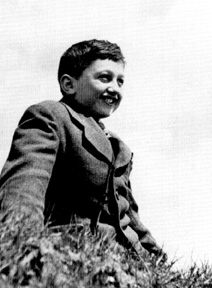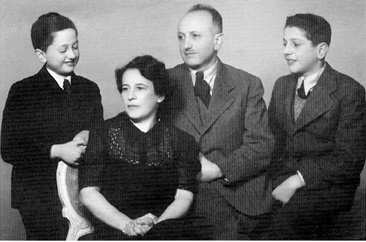
About 150 kilometers (ninety-five miles) south of Prague, the capital city of the country that was once called Czechoslovakia, there is a town called Budejovice (pronounced Boo-day-ho-vee-tsay). The Czech king Premsyl Otakar 11 established the town a long time ago, in 1265. It lies in a valley where the rivers Vltava and Malse (pronounced Mal-sheh) come together and encircle the entire town, like a giant moat around a castle.
In the center of town is a broad plaza called the Square of King Premsyl Otakar 11, paved with cobblestones and surrounded by multicolored buildings, fruit and vegetable stalls, and vendors selling their wares. In the middle of the square is a tremendous fountain; when it was constructed, back in 1721, it was the town’s water supply. A statue of Samson taming a lion dominates the center of the fountain. In another corner of the square rises the hugely tall Black Tower with its clock and bell that chimes out every hour.
In the 1930s, Budejovice was a small city with many businesses, schools, restaurants, and theaters, and the bustling traffic of streetcars, carts, cars, and pedestrians. At that time, there were about fifty thousand people living there. Of that number, approximately one thousand were Jewish. The people of the Jewish community had all sorts of jobs: they owned small businesses, and they were doctors, teachers, artists, and salespeople. Some were wealthy and some were poorer. But even the poor Jewish families lived in pleasant small apartment buildings and had enough money to live comfortably. All of these families lived, worked, and went to school together with their Christian neighbors. Although there was a small population of very religious Jews who followed strict Jewish traditions, most of the Jewish families lived much the same lives as the rest of the town.
John Freund was born in this lovely medieval town on June 6, 1930. By the time he was nine years old, he had grown into a slender boy with a full head of thick, curly brown hair and deep-set dark eyes. More than anything, John loved sports, particularly soccer, and for his age and size he was fit and muscular. His father, Gustav, was a pediatrician, and his office was just a fifteen-minute walk from the family apartment. John loved to pretend that he was sick just so his father would spend time doctoring him, as he did the many sick children he attended so lovingly. John’s mother, Erna, stayed at home to look after the family. She was a cultured woman who knew all about poetry and music. John loved going shopping with her, especially when she headed for the market in town. The best part of the trip came at the end. If John was lucky and well-behaved, he was rewarded with a fresh roll heaped with thinly sliced meat – his favorite treat.
Karel was three years older. He could be a bully, and he was often mean to John, grabbing things from him or hitting him for no apparent reason. One day, when John was just seven years old, Karel locked him in the yard next to their apartment building. “Karel, let me out!” John yelled. He kicked the tall gate and shouted, “I’ll tell Mother and Father if you don’t let me out.” On the other side of the gate, Karel laughed. He wasn’t afraid of his young brother or his parents. Karel was tough and rebellious, not at all like the milder-mannered John.

John at the age of nine.
But to John this was no longer funny. By now, he was scared. In desperation, he bent down, picked up a heavy rock, and heaved it over the gate. It hit its target, smashing into Karel’s head and causing him to bleed quite badly. Karel was taken to the hospital for stitches, and John was in serious trouble. “This is inexcusable!” his father exploded. “What on earth were you thinking when you threw that rock?”
John tried to protest – after all, Karel had started the whole thing by locking him in the yard in the first place. But his parents would not listen. They even asked their rabbi, Rudolph Ferda, to talk to John about his behavior.
“What if there had been a mother wheeling a baby carriage past when you threw that rock?” demanded Rabbi Ferda. The rabbi was a kind and sensitive man, well liked by everyone in town, and his scolding embarrassed John. John stared at him, but found it hard to listen to what the rabbi was saying. Instead, he focused on the rabbi’s full mouth of teeth, all painted gold to prevent cavities. Besides, John was secretly pleased with himself for finally standing up to Karel.
For the most part, John was better behaved than Karel, but not always. He could create his own share of trouble. One day, for example, John had a few friends over. The Freund family lived in a four-room apartment on the second floor of a four-story building in an attractive part of town. Their apartment was spacious and beautifully decorated, with dark wooden floors, high arching ceilings, and large bright windows. John shared his bedroom with Karel. When John looked out his bedroom window, he could see the red brick of his school just two blocks away.
That day, John’s mother was out shopping and his father was at his office, attending to his patients. “You may have your friends over to visit, but make sure everyone is well-behaved,” John’s mother had warned as she had left for the market. John had nodded, happy for the opportunity to be left alone. He was young to be in the apartment by himself, but – like most children at that time – he was given a lot of freedom. There were few dangers in Budejovice, and most of his neighbors knew him and would watch out for him if there was trouble.
John’s friends arrived and started playing a wild game of tag, and the warning from John’s mother was instantly forgotten. The boys made so much noise that someone in the building notified the landlady, a sour old woman named Mrs. Kocher. Up the stairs she waddled, pounding on the Freund apartment door. “Let me in, now!” she demanded. Inside, the boys froze. No one dared open the door. Finally Mrs. Kocher pushed through the door and the boys scattered, climbing onto furniture and hiding behind chairs. Waving a big, bristly broom, Mrs. Kocher chased John out of the closet and around the dining-room table, whacking him sharply whenever he was within range!
Another stern lecture from John’s parents followed this adventure.
Life was lively for John growing up in Budejovice. And he did all the things that young people his age loved to do. He played marbles on the sidewalk, close to the blacksmith shop. He played soccer and hockey on the street in front of his apartment building. He was a good soccer player and could easily outrun the other children. He went ice-skating at the local arena. He sometimes rode the tram winding its way through town, toward the square and beyond it, to the northern part of the city.
“Be careful on the streetcar,” his parents cautioned him. “Don’t get off until it comes to a complete stop.” But John was young and daring, and he ignored his parents. He would wait until the streetcar slowed down, and then leap into the air, hoping to land feet first. That didn’t always happen. Often he would tumble onto the pavement, scraping his knees. But that hardly mattered to him. Jumping from the tram was a test of his courage.
Another test of courage was climbing to the very top of the Black Tower. The first time John met this challenge, he was terrified. He walked through the doors of the tower into its cool, dark interior. It was completely quiet inside, and he felt a spine-tingling chill run through his body as his eyes adjusted to the darkness. He moved toward the narrow staircase and held his breath as he hiked up the treacherous steps of the tower, climbing in complete darkness, feeling his way across a narrow ledge. Despite the cold dampness, he felt sweat trickling down his back. I can’t turn back now, he thought, as he scaled a wooden ladder up to the open space on top of the tower. Finally he burst into the sunlight, his heart pounding, his eyes dazzled by the brightness. He clung to the stonework, his knees suddenly shaky, and gazed in all directions. The view was magnificent. It was absolutely worth the climb.
John’s father owned a car, and on some Sundays his mother would pack a picnic and the four of them would drive to nearby Klet Mountain. The hillsides were rich with deer, bears, wolves, and foxes, as well as huge rocks. Legend had it that there had once been a massive castle on this high mountain, and that in it had lived, and ruled peacefully, the Duke Hrozen. The duke had only one daughter, the beautiful Krasava. Many boys wished to marry her – especially a handsome boy with a dark face and sparkling eyes, who was dangerous and devilish. When it was discovered that he actually was the Devil, the horrified Krasava rejected him, and he swore revenge. One day when everyone from the castle was away on a hunt, he created a terrible storm above Klet, which demolished the stone walls of the castle and littered the mountain with these great boulders.

The Freund family, (left to right) John, his mother, Erna, his father, Gustav, and his brother, Karel.
It was there, close to the mountains, that John and his family spent their summers, in a farmer’s house that they rented, near a village. It was a small but comfortable farmhouse with an old barn next to it. John walked in the forest and swam in the pond. He caught butterflies with his net and played with the village children. Those were sweet summers, full of joy and adventure, and Budejovice was a wonderful place in which to grow up. John could go anywhere and do just about anything. He had good friends, a loving family, and a happy home. He could not imagine that his life would ever change.